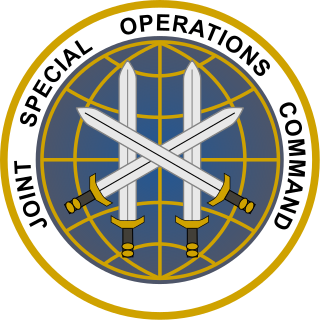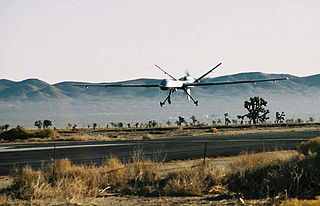
Operation Anaconda or the Battle of Shah-i-Kot was a military operation that took place in early March 2002 as part of the War in Afghanistan. CIA paramilitary officers, working with their allies, attempted to destroy al-Qaeda and Taliban forces. The operation took place in the Shah-i-Kot Valley and Arma Mountains southeast of Zormat. This operation was the first large-scale battle in the post-2001 War in Afghanistan since the Battle of Tora Bora in December 2001. This was the first operation in the Afghanistan theater to involve a large number of U.S. forces participating in direct combat activities.

The 160th Special Operations Aviation Regiment (Airborne), abbreviated as 160th SOAR (A), is a special operations force of the United States Army that provides helicopter aviation support for special operations forces. Its missions have included attack, assault, and reconnaissance, and these missions are usually conducted at night, at high speeds, low altitudes, and on short notice.

Fazul Abdullah Mohammed was a Comorian-Kenyan member of al-Qaeda, and the leader of its presence in East Africa. Mohammed was born in Moroni, Comoros Islands and had Kenyan as well as Comorian citizenship. He spoke French, Swahili, Arabic, English, and Comorian.

Task Force 20 is a temporary combat force designation that has been used several times and may still be used by separate parts of the United States armed forces. The longer-established iteration was a part of the United States Second Fleet in the Atlantic from after the Second World War. This was part of the formal United States Military Communications-Electronic Board system.

The Joint Special Operations Command (JSOC) is a joint component command of the United States Special Operations Command (USSOCOM) and is charged with studying special operations requirements and techniques to ensure interoperability and equipment standardization, to plan and conduct special operations exercises and training, to develop joint special operations tactics, and to execute special operations missions worldwide. It was established in 1980 on recommendation of Colonel Charlie Beckwith, in the aftermath of the failure of Operation Eagle Claw. It is headquartered at Pope Field.

The Special Forces Support Group (SFSG) is a special forces unit of the British Armed Forces. The SFSG was formed officially on 3 April 2006 to provide support to the Special Air Service, the Special Boat Service and the Special Reconnaissance Regiment on operations. It is a tri-service unit, composed of the 1st Battalion, Parachute Regiment,, a company of Royal Marine Commandos, and a flight (platoon) from the Royal Air Force Regiment.

Saleh Ali Saleh Nabhan was the leader of al-Qaeda in Somalia. He was listed on the FBI's third major "wanted" list, the FBI Seeking Information – War on Terrorism list, for his association with multiple attacks in Kenya in 2002, as well as his possible involvement in the 1998 United States embassy bombings, in which over 250 people lost their lives.

Operation Enduring Freedom – Horn of Africa (OEF-HOA) is a component of Operation Enduring Freedom (OEF). The Combined Joint Task Force – Horn of Africa (CJTF-HOA) is the primary military component assigned to accomplish the objectives of the mission. The naval components are the multinational Combined Task Force 150 (CTF-150) and Combined Task Force 151 (CTF-151) which operates under the direction of the United States Fifth Fleet. Both of these organizations have been historically part of United States Central Command. In February 2007, United States President George W. Bush announced the establishment of the United States Africa Command which took over all of the area of operations of CJTF-HOA in October 2008.

The Battle of Ras Kamboni took place during the Somalia War (2006–2009) fought by the Islamic Courts Union (ICU) and affiliated militias against Ethiopian and the Somali Transitional Federal Government (TFG) forces for control of Ras Kamboni, a town near the Kenyan border which once served as a training camp for the militant Islamist group Al-Itihaad al-Islamiya.
Abu Talha al-Sudani, was a Sudanese member of Al Qaeda terrorist organization, an explosives expert and a close aide of Osama bin Laden.
At 3:25 a.m. on 3 March 2008, two BGM-109 Tomahawk cruise missiles launched by a United States Navy warship hit the village of Dobley in Somalia. According to US military officials the target of the attack was an al-Qaeda leader. Dobley district commissioner Ali Hussein Nuir stated that Sheikh Hassan Abdullah Hersi al-Turki, a local militant cleric was meeting with leaders of a Mogadishu-based militant group nearby. Varying reports of casualties surfaced with villagers reporting that between four and six people were dead. It is unclear whether these casualties were targets or civilians. Villagers also reported that an aircraft had attacked them, but US military officials denied these reports merely stating that an attack had indeed occurred and that they were looking into the results. At least two previous attacks of a similar nature occurred in 2007 where American forces targeted suspected al-Qaeda operatives in Ras Kamboni as well as in Bargal.

Operation Viking Hammer was an unconventional warfare operation during the Iraq War which took place in northern Iraq, commonly known as Iraqi Kurdistan. The goal of the operation was to eliminate Ansar al-Islam and dismantle the Islamic Emirate of Byara. Ansar al-Islam was established by former Al-Qaeda members in 2001 as a Kurdish Salafist movement that imposed a strict application of Sharia in villages it controlled.

The Joint Special Operations Command Task Force which fought in the Iraq War was a joint U.S. and British special operations temporary grouping assembled from different units. It has been described as a "hunter-killer team" with its core made up of the United States Army's 1st Special Forces Operational Detachment-Delta and the 75th Ranger Regiment, as well as the United States Naval Special Warfare Development Group and members of the United States Air Force's 24th Special Tactics Squadron, all under Joint Special Operations Command (JSOC) and elements from the United Kingdom Special Forces, including the Special Air Service, Special Boat Service (SBS), Special Reconnaissance Regiment (SRR), 18 (UKSF) Signal Regiment and the Special Forces Support Group (SFSG). The task force was reported to be responsible for the cross border raid into Syria from Iraq in October 2008 that resulted in eight deaths including Abu Ghadiya, along with several US operations in the Horn of Africa targeting al-Qaeda.

The Somali civil war (2009–present) is the ongoing phase of the Somali civil war which is concentrated in southern and central Somalia. It began in late January 2009 with the present conflict mainly between the forces of the Federal Government of Somalia assisted by African Union peacekeeping troops and al-Shabaab militants who pledged alliegence to al-Qaeda during 2012.
The War on Terror is the campaign launched by the United States of America in response to the September 11 attacks against organizations designated with terrorism. The campaign, whose stated objective was eliminating international terrorism, began in 2001. The following is a timeline of events linked to the War on Terror.

The 2014 hostage rescue operations in Yemen were missions to rescue hostages held by Al-Qaeda in the Arabian Peninsula (AQAP) in Yemen. The first attempt on 26 November 2014 rescued 8 hostages, but five hostages, including the American journalist Luke Somers, were moved by AQAP to another location prior to the raid. The second attempt by U.S. Navy SEALs once again attempted to rescue the hostages, but Luke Somers and South African teacher Pierre Korkie were killed by AQAP during the raid in Shabwah Governorate of Yemen.

Since the early 2000s, the United States has provided military support to the Transitional Federal Government and the Federal Government of Somalia in conflicts. U.S. military actions in Somalia date back to the 1980s, however following the September 11th attacks, military action was justified as counterterrorism. The Obama administration and the Trump administration conducted drone and fighter aircraft strikes, advisory missions, training, provided intelligence, and attacked al-Shabaab militants. Two U.S. special operations personnel, two contractors, one US Army soldier, and a CIA paramilitary officer have died during operations in Somalia.













